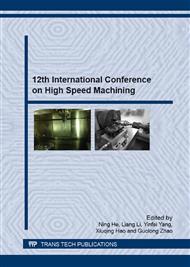p.185
p.191
p.198
p.205
p.215
p.220
p.228
p.234
p.242
Study on Oxidation Resistance of Tool Materials for Machining Superalloy
Abstract:
The high temperature oxidation phenomenon will occur on the tool-workpiece contact area when machining the superalloy. Two kinds of cemented carbide tools (YG6X, YG8) are selected, the coated carbide tool and coated ceramic tool which are suitable for machining superalloy are selected. The resistance furnace is used for heating tool material, and the oxidation resistance experiments are carried out. The results show that: WC which is included in the cemented carbide tool is oxidized to WO3 and the Co is oxidized to Co3O4, Ti which is included in the coated carbide tool is oxidized to TiO2. The grain of the tool is smaller, the oxidation resistance is better. The oxidation resistant of coated carbide tool is better than the non-coated tools. The coated ceramic tool is not substantially oxidized in high temperature situation. The merits order of the oxidation resistant properties is that: coated ceramic tool>coated carbide tool > YG6X>YG8.
Info:
Periodical:
Pages:
215-219
Citation:
Online since:
January 2016
Authors:
Keywords:
Price:
Сopyright:
© 2016 Trans Tech Publications Ltd. All Rights Reserved
Share:
Citation:


